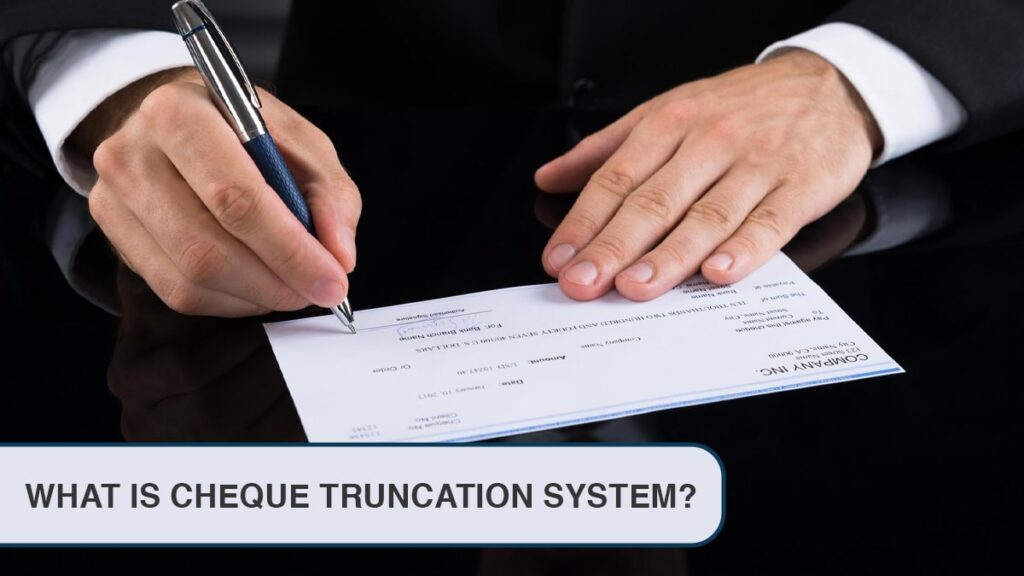Ever wondered how your cheques are being processed by the bank or how accurately the entire Cheque-clearing system works?
You often find the bank clerk or the Cheque collection box being used to collect the Cheque for the bank to process the Cheque.
The system using which the Cheque is being processed is called the Cheque Truncation System (CTS). In this article, we will discuss what a is Cheque Truncation System, What its benefits are, how it works, and much more.

What is Cheque Truncation System?
The Cheque Truncation System is a cheque verification system set by the banks to process the cheques of the customer with more accuracy and for faster turnaround time.
The tools work by analyzing the cheque image and magnetic ink present in the cheque to read the MICR code. It captures the details of the cheque at the collecting bank branch and transmits it electronically.
Traditionally, the cheques have to be moved physically to the cleaning branch to get the cheque processed. It was time-consuming and may attract problems in logistics, so RBI replaced the system by introducing the Cheque Truncation System (CTS).
The Cheque Truncation System has a comprehensive PKI-based security architecture that provides basic security and authentication controls.
Benefits of Cheque Truncation System
The following are the Benefits of the Cheque Truncation System-
- The Cheque Truncation System allows the banks to have a quick turn-around time
- It acts as a centralized image of the archival system keeping the details of the cheques safe
- Minimize the risk by removing human error and providing a secure system for cheque processing
- It saves costs for the banks because it lowers the costs of the physical movement of the cheques which saves the cost of logistics
- This system stores data which helps in retrieval of the data become easy
How does the Cheque Truncation System Work?
The Cheque Truncation System works by processing your cheques and depositing your money into the account of the cheque sender. The following are the steps that the Cheque Truncation System takes to process your cheque-
Collection of Cheques
The very first step that the system uses is the collection of the cheques. Your local bank branch can act as a point of collection for the cheques.
There are two ways you can deposit the cheques-
- Using Cheque Dropbox- Submit the cheque by filling out the cheque deposit slip and dropping the slip and cheque in the cheque box
- Using a Cheque Deposit Machine- Cheque Deposit Machine that requires you to follow a few steps to submit your cheque.
Capturing of Data
The bank branch has a system installed on their branch which captures the Data of the cheque for further processing. The data is captured in two ways, first, from the MICR band and then the images of a cheque using their Capture System. This data then is fed into the system ensuring the security and safety of the data.
Security of Data
The CTS System comes with safety and security features that prevent any repetition of the data and consists of a scanner, core banking, or other applications. The entire system is protected by nd-to-end Public Key Infrastructure. The bank branch then sends the data and captured images duly signed digitally and encrypted to the central processing location.
Clearing House Interface
The central processing location is called the Clearing House Interface which processes the data sent by the bank and further routes the images and requisite data to the paying banks. This process is called Presentation clearing.
Processing of Payment
The paying bank uses a Clearing House Interface (CHI) or Data Exchange Module (DEM) to receive the data from the clearing house. Upon receiving, the paying bank process the data make the deduction from the cheque issuer, and send it to the receiving bank’s account.
Completion of Cycle
After sending the amount, a verification process gets initiated wherein the paying bank sends back the processed confirmation data to the clearing house which is forwarded to the receiving bank for confirmation. After confirmation, the entire cycle of the CTS is completed, and the bank starts to notify the receiver as well as the sender about the completion of the processing of the cheque.
FAQ
Banks nowadays only issue CTS-compatible cheques which adhere to the standards set by RBI. If you have older cheques then it is advised to replace the old cheques with new ones by applying to your bank branch for new cheque leaves. Non-CTS cheques are still valid and can be used but not advised.
While writing cheques you should use a blue or black color ball pen with a clear and smooth impression. The cheque’s information should be correct including the signature, date, and amount. Avoid any alteration or modification including any correction or use of fluids. In case of any error in the information, you’ll have to start with fresh cheque leaves.
To Prevent cheque-related frauds, RBI recommends that banks implement a Positive pay system which is an additional security layer in the CTS system. It is at the discretion of the bank to implement the system for cheques amounting to Rs.50,000/- but is mandatory in the case of Rs.5,00,000 and above.
If a customer wants then, the bank can provide the images of the cheques duly certified and authenticated. But for the physical cheque, would need to be sourced from the presenting bank for which the request has to be made to his/her bank. It may involve some charges. Legally, the banks have to preserve the physical cheque for 10 years.



